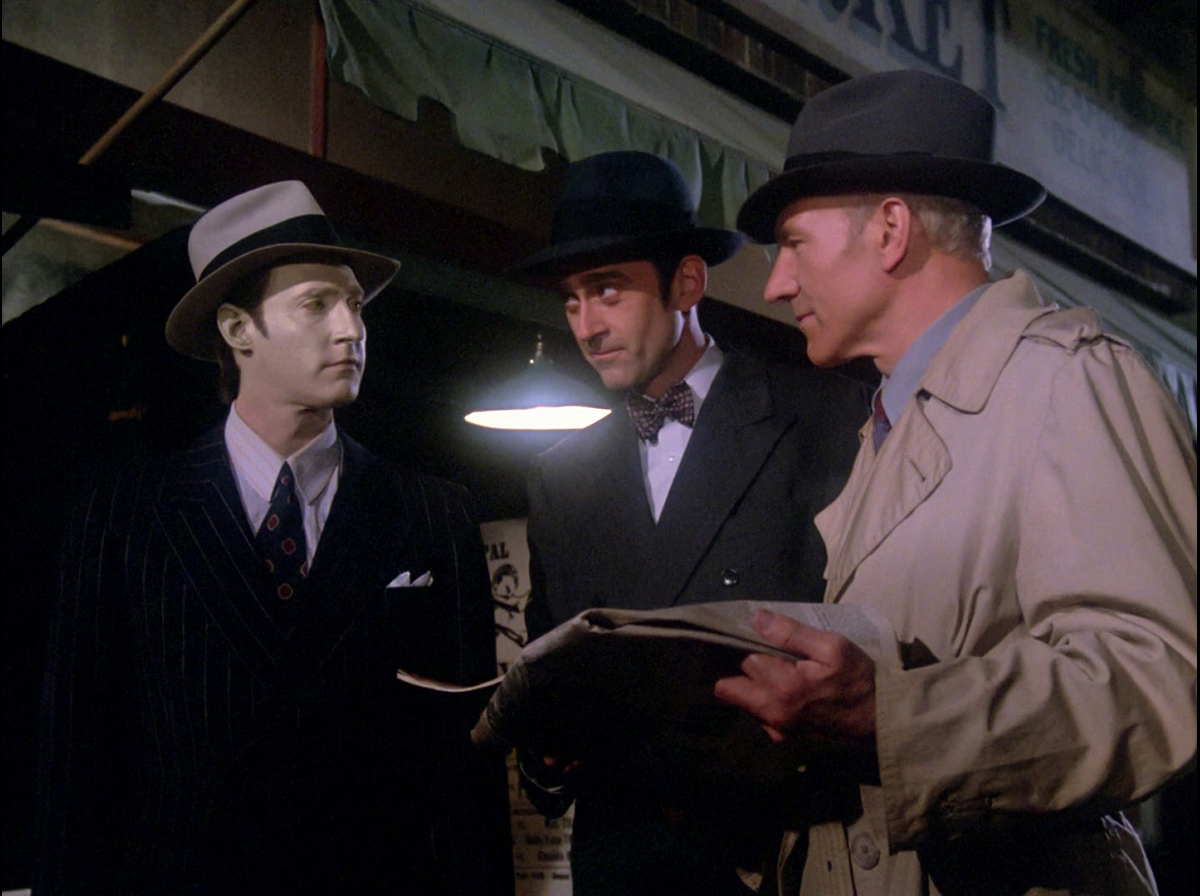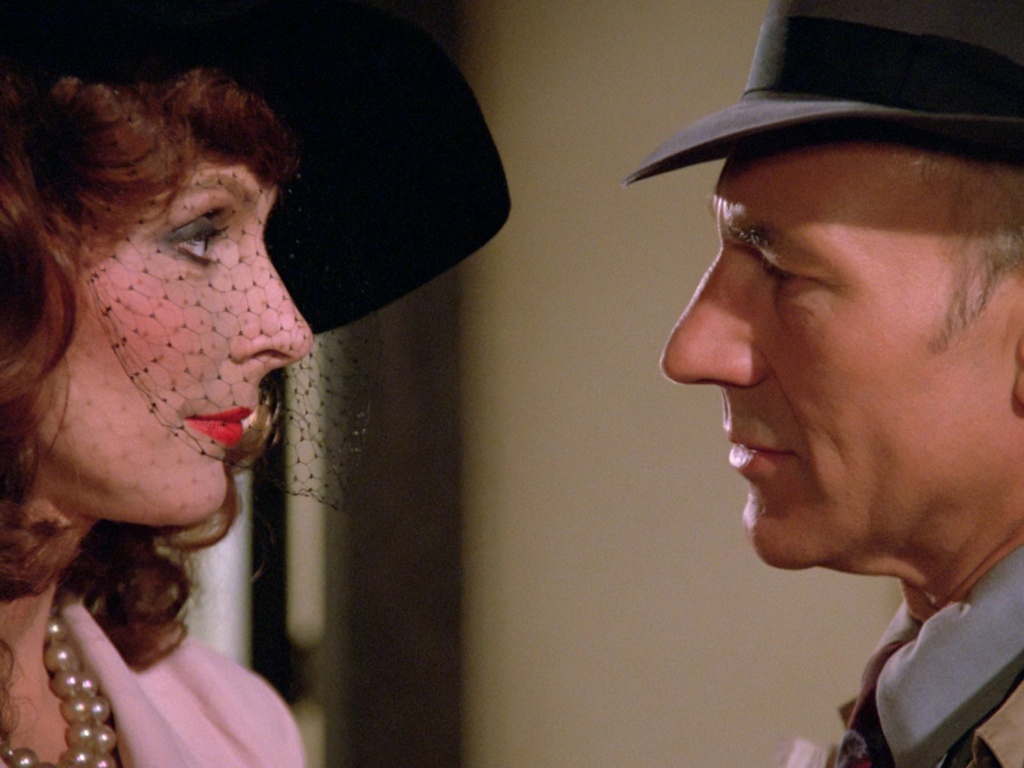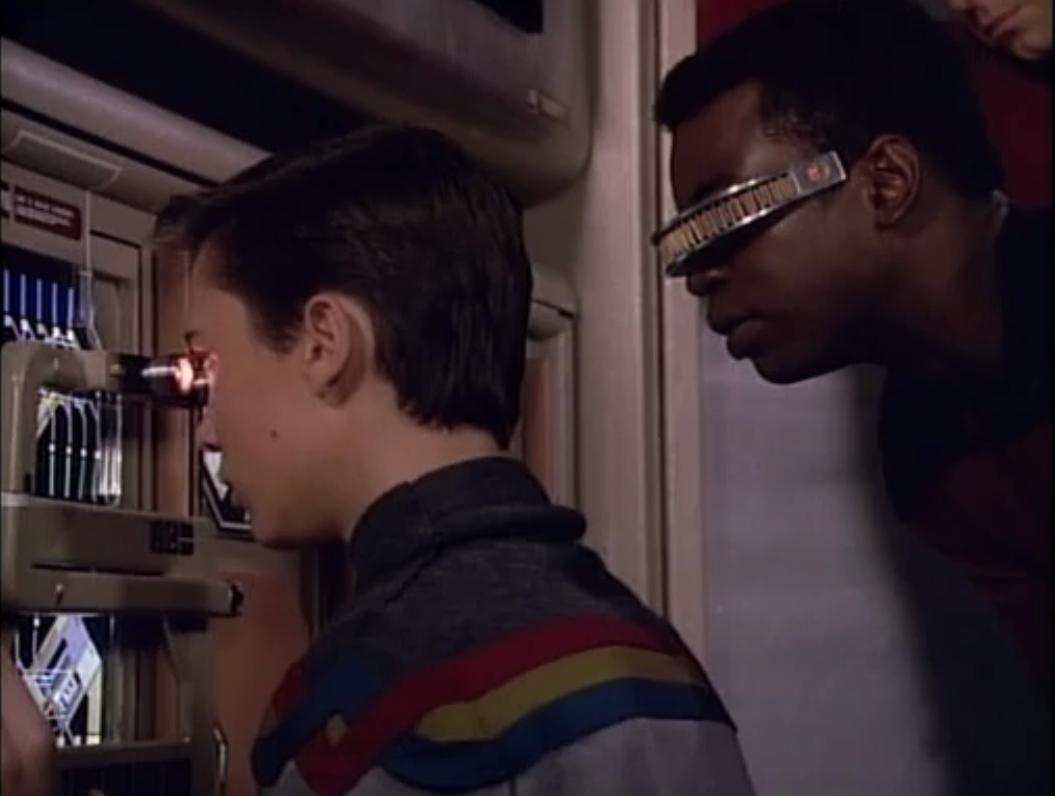
Picard is all stressed as he prepares to give a very elaborate greeting to a very protocol-driven (read: anal) alien species called the Jarada. Troi tells him he needs a break, so Picard checks out the upgraded holodeck — now capable of characters with more human interaction. He chooses to play the role of 20th-century American gumshoe Dixon Hill, a longtime hero. Picard is so amazed with the results after a brief visit that he returns with Data, Crusher and historian/redshirt Whalen (David Selburg). While they’re inside, the Jarada probe the Enterprise, messing up the holodeck, trapping our heroes and removing the safeties. Gangster Cyrus Redblock (Lawrence Tierney) shows up in Hill’s office and shoots Whalen. Realizing they’re cut off from the rest of the ship and in danger, Picard and Co. tell Redblock that they’re actually engaging in a simulation and — after Wesley and Geordi fix the holodeck — Redblock and one of his toadies exit (looking for new plunder) only to disappear. Data and Crusher then hurry Whalen to sickbay and Picard has a short discussion with a non-bad holodeck character who wonders whether his world will continue after Picard leaves. Picard tells him he honestly doesn’t know and heads to the bridge — where he does the weird Jarada greeting successfully.

Why it’s important
Although this episode has some first-season issues (which we’ll get to in a moment) it’s a huge moment for Star Trek storytelling in at least three ways:
1) It sets up the second-generation Trek’s version of the “parallel Earth” stories. Fortunately, it’s much more believable in TNG, DS9 and Voyager than on TOS because our heroes are actively creating 20th-century Earth scenarios, rather than randomly finding them on far-flung planets, like in “Bread and Circuses”.
2) It sets up the “holodeck accident” trope that became a fixture for the next 14 or so years. This had mixed results, from good episodes like “Elementary, Dear Data,” “Our Man, Bashir,” and “Worst Case Scenario” to awful ones like “Good Shepherd.” There were a lot of “meh” episodes thrown in, too.
3) But probably most important is the idea of holographic characters becoming sentient. That led to the successful “Elementary, Dear Data”/”Ship in a Bottle” arc in TNG, the somewhat successful Vic Fontaine stories in DS9 and, of course, Voyager’s best character, the Doctor.
It’s unclear how much of what happened in “The Big Goodbye” and later “Elementary, Dear Data” prompted Starfleet to design sentient holograms like the Doctor. But, it’s pretty obvious the Star Trek creators got the idea for sentient holograms in the early TNG stories. Either way, this episode lays a lot of foundation for later Trek.

What doesn’t hold up
The episode suffers from what I call “M*A*S*H Syndrome” — where main characters are put into positions simply because they’re main characters and not because people in their roles would realistically interact in such a way. It comes across as if the handful of characters played by the show’s stars only interact with each other — even though there are many more people around. Voyager was actually the worst series as far as this problem, but TNG had its share, too. The key scene in this episode is in the observation lounge following Picard’s first visit to the holodeck.
Simply put, having everyone in that scene was weird. Later TNG might have Picard telling Riker or Data or Troi about his adventure. But there’s no way Picard in the fourth or fifth season would take time away from the Jarada briefing for something like this. And there’s no reason for Wesley (who’s usually only in briefings in the series when he’s working on something with Geordi) to be in the scene. Wesley’s involvement later in rescuing Picard and Co. still could have happened.
This episode also is the clearest example of Picard and Crusher having feelings for each other that we see until the seventh season, as the whole ordeal in “The Naked Now” could be chalked up to the weirdness that happened to the entire crew. It’s frankly a little over the top here — particularly in the observation lounge (with the entire senior staff and Wesley present) and knowing where Picard comes down on romantic relationships with crewmembers.
Otherwise, there’s only really one big issue — why Geordi, Wesley or one of the other engineering dudes didn’t rush into the holodeck after it was fixed to tell Picard that the Jarada were waiting. It’s also odd that Redblock and his crony didn’t see any of Geordi’s team when they exited.
Final thoughts
To be fair, the above complaints don’t rank very high and “The Big Goodbye” was a clear step in the right direction after a lot of bad television in TNG’s first several episodes. As long as you don’t dislike holodeck stories generally, this isn’t a bad view. It was fairly original when it aired. And the Redblock character added some interesting wrinkles to the show’s final minutes, as he clearly was a well-conceived holodeck character.
Just as “Tomorrow is Yesterday” should be gently viewed as TOS’s first time-travel story, “The Big Goodbye” should be viewed as TNG’s (actually, all of second-generation Trek’s) first holodeck problem story. From that perspective — and compared with a lot of the dreck from early TNG — it works quite well.
Coming later this week …
We learn about Data’s backstory, off switch and inability to use contractions. But it’s cool. He’s fine …
